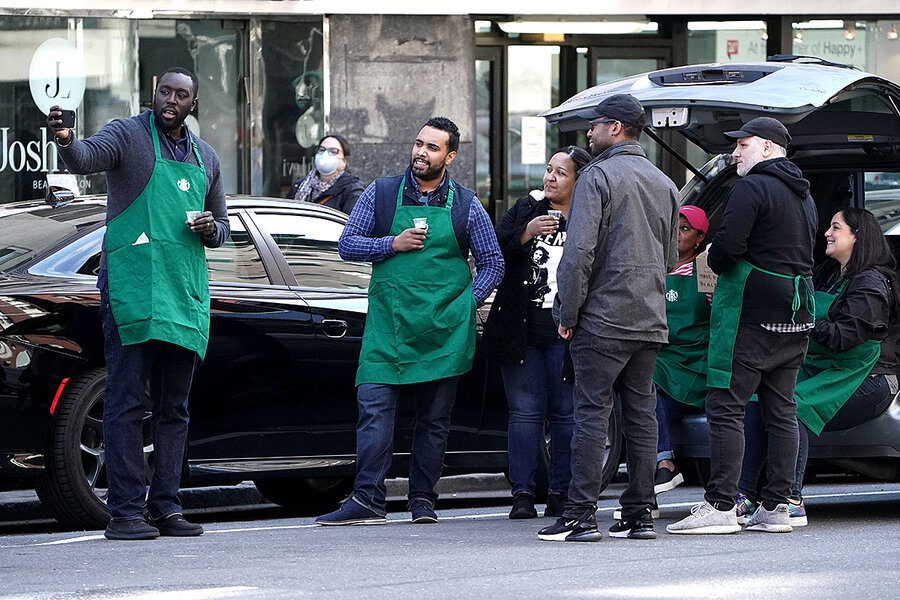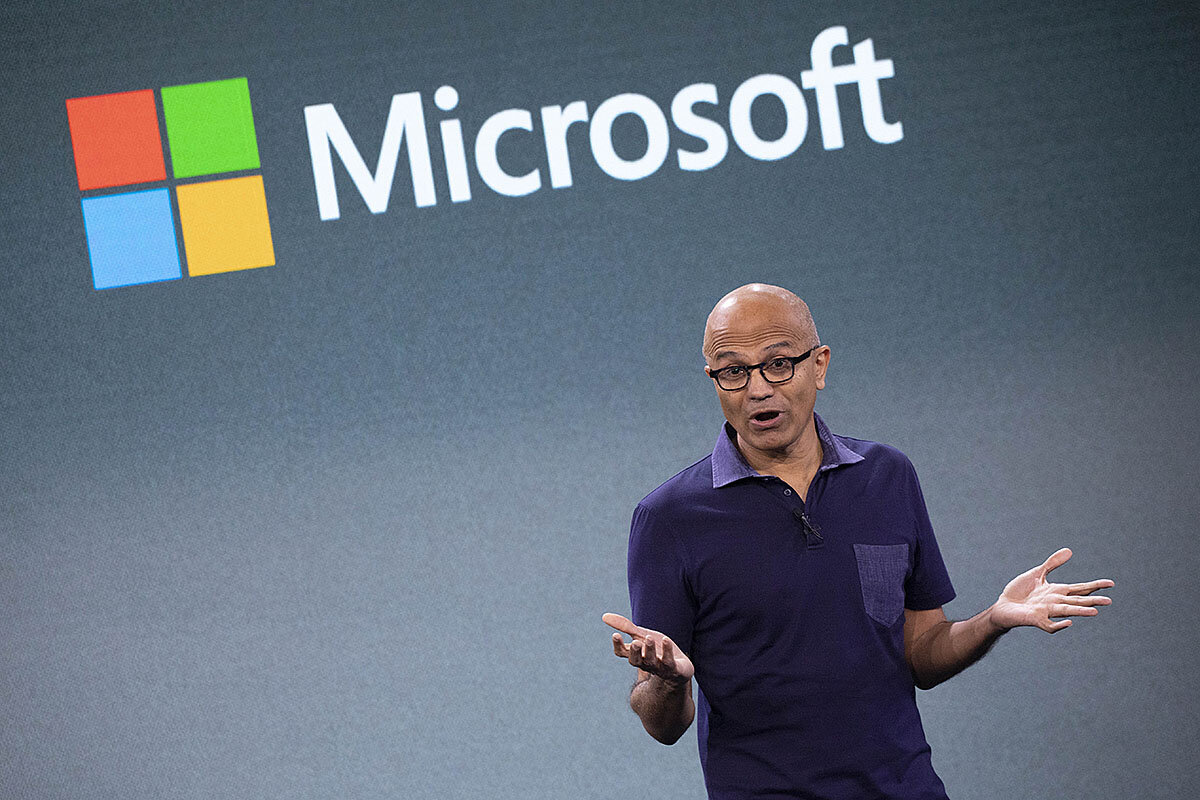Corporations pledge to fight racial inequality. Will it work?
Loading...
The online announcement had the usual lineup. Mayors and educators spoke about the importance of career readiness grants for Black and Latino residents in their cities. What was unusual about Tuesday’s event was the host, which wasn’t a foundation or the federal government.
It was JPMorgan Chase, America’s largest bank.
For several minutes on-screen, CEO Jamie Dimon talked about the need to address the nation’s long-term racial inequality through better career-prep in schools. The bank’s philanthropic arm is committing $35 million to a five-city, five-year effort to improve career readiness in underserved communities, part of a much larger corporate effort to tackle racial inequality. “To fix the problem, you’ve got to acknowledge it,” said Mr. Dimon, who is one of the many white Fortune 500 CEOs deploring America’s persistent racism.
Why We Wrote This
In the wake of national protests against racial injustice, many businesses are committing to ambitious diversity goals in hiring and investment. The hope of progress is real, even if it’s at best a partial solution.
Ever since May, when the death of George Floyd drew national attention to violence by police, corporate America has been talking about narrowing racial inequality. Now, spurred also perhaps by evidence that the pandemic has hit Black and Latino Americans especially hard, they’re doing something about it.
In the past two months alone:
•JPMorgan Chase announced a wide-ranging $30 billion five-year plan that spans from building affordable housing and improving access to loans to funding community development groups. Rival Bank of America has issued a $2 billion “equality progress sustainability bond” – the first of its kind – aimed at advancing racial equality, economic opportunity, and environmental sustainability. Citi has announced its own $1 billion investment to combat racial inequality.
•Coffee chain Starbucks announced steps – including a mentorship program for senior executives – aimed at achieving 30% people of color at all corporate levels by 2025.
•IBM announced a research initiative to create a diverse workforce in quantum computing by offering access to its superfast computers to Howard University and a dozen other historically Black colleges and universities.
Even the Federal Reserve has launched a series of online events this month on structural racism and inequality. In the wake of Fed research showing that few Black homeowners had refinanced their mortgages to lower rates, the Fed has resolved it needs to get the word out to all communities.
Citibank calculates that if the U.S. could somehow close the racial gaps in wages, housing, higher education access, and business investment, the economy would add $5 trillion of economic activity and a third of a percentage point to annual growth over the next five years.
While it’s far too early to assess whether these initiatives can achieve that, their size and the fact that corporate chieftains are saying, sometimes for the first time, that racism in America is systemic are seen by many as a step forward.
“I was ecstatic when I saw the announcement from Chase,” says Gary Cunningham, president and CEO of Prosperity Now, a nonprofit aiming to build wealth for low-income people that received funding from Chase.
But big efforts that helped build the middle class, especially the white middle class, such as federal guaranteed home loans during the Great Depression and the GI Bill after World War II, were government efforts, he points out. “There has to be both a public and private approach.”
What will success look like?
JPMorgan Chase “stands out to me in being a little ahead of the game,” compared with other firms, says Dedrick Asante-Muhammad, chief of race, wealth, and community at the National Community Reinvestment Coalition in Washington. But the proof will come when corporations begin to reflect the nation’s diversity in their own workforces and contracts to minority-owned firms.
“It would be a serious step forward if major corporations start having procurement contracts with Black businesses – getting away from [a token] 1%, 2% to 10%” of business to outside contractors, Mr. Asante-Muhammad says.
Best Buy has committed to find and nurture Black- and minority-owned manufacturers of products that it would sell. In June, General Motors CEO Mary Barra created a financial inclusion board of company officials and outsiders with the goal, she said, of “making GM the most inclusive company in the world.”
Another encouraging sign is that many of these companies are building on diversity initiatives already underway. In June, AT&T announced it was nearly 90% toward its commitment to spend $3 billion with U.S. Black-owned suppliers by the end of this year.
The flip side is that, for all the recent commitments, racial inequities in corporate hiring have been deep and persistent. The National Community Reinvestment Coalition and Beneficial State Foundation found that Black and Latino people together hold only 7% of mid-level management positions in the financial industry, even though they make up 13% and 18% of the population, respectively. At senior level positions, they hold only 3% and 4%, respectively.
In some areas, representation for employees of color has actually gone down. In the hotel and lodging industry, for example, white workers held 71% of the top management positions in 2007, according to an NAACP report last year. By 2015, that share had risen to 81%.
That was before the pandemic, which decimated the industry and has hit Black and Latino Americans particularly hard. Besides a COVID-19 fatality rate that’s twice as high for Black Americans as for white Americans, the economic downturn has shut down thousands of small businesses and caused unemployment to soar. In February, the Black unemployment rate stood less than 3 percentage points above the rate for white Americans; by September, the gap had grown to 5 percentage points.
The quest for effective solutions
The challenge is multifaceted in part because racial disparity is spread across the economic spectrum: from unemployment and wealth to housing and even venture capital. A report from Crunchbase this month found that Black- and Latino-owned firms got only 2.4% of venture funding even though they make up 32% of the population.
Not everyone is optimistic that the current rush of corporate activity will end well.
“There are a number of corporations as well as philanthropic entities that are facing enormous pressure to mobilize their resources” on behalf of Black Americans, says Ian Rowe, resident fellow at the American Enterprise Institute and cofounder of Vertex Partnership Academies, which will be opening new charter schools in the largely Black and Hispanic south Bronx in 2022.
Like many Black Americans, he says that racism does still create disadvantages for some people of color, even as many have made enormous progress by embracing the ideals of family, faith, hard work, and entrepreneurship. But as society tries to address those disadvantages, he says a vital step is to nurture the personal agency of Black Americans themselves through a success sequence that starts with education and job skills.
If corporations send a signal that there’s nothing a Black individual can do to improve his or her lot, they will undercut racial dignity and contradict the companies’ own values, such as merit-based success, Mr. Rowe says. He deplores as a double standard the way one small bicycle company briefly offered Black customers a discount that wasn’t available to other customers. (The firm is currently rethinking its approach to its “reparations” program.) By contrast, he applauds companies like Netflix, which is shifting as much as $100 million of its cash to Black-owned banks and community lending organizations, because those lenders will evaluate entrepreneurs on the strength of their business plan rather than the color of their skin
Corporate initiatives will work “only if it’s in line with their core values,” Mr. Rowe says. “Otherwise, they won’t endure.”
Indeed, efforts to help entrepreneurs of color hint at the complexity of solutions.
“Banks today generally want to make loans of $1 million or more and they generally want to lend to entrepreneurs that have three years of audited financials,” says Michael Schlein, president and CEO of Accion, a nonprofit that lends to small businesses in developing nations as well as in the United States. “Most small businesses don’t have three years of audited financials and don’t need $1 million. They need $40,000.”
He applauds businesses that are putting money into minority-owned banks and community-based lenders who specialize in these small loans. Yet many times these loans aren’t profitable, Mr. Schlein adds.
Whereas Accion can lend sustainably to entrepreneurs with no credit scores in other nations, its U.S. arm struggles because potential clients walk in with bad credit scores, which muddies the outlook on the viability of their business.
“We work weeks or months to help entrepreneurs to separate personal and business” debt, he adds, which raises costs. He’s hopeful that by scaling up the business and using the latest financial technologies, Accion can eventually make such U.S. lending not only profitable but also attractive to commercial lenders.
Looking at the broader array of corporate efforts, Mr. Dimon of Chase is also upbeat: “You have 200 of the biggest companies in America pretty much devoted to this issue. ... [Then] if you get the local civic society, the community colleges, the governor, the mayor working together, we will win.”







